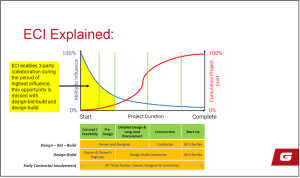
Early involvement, greater collaboration and common technology platforms converge to improve project outcomes
By David Bowcott
Risk ManagementOver the summer, the Canadian Construction Association (CCA) had one of its members, Graham Construction, present at its National Advisory Council meetings on the topic of Emerging Contract Models for Better Projects (Early Contractor Involvement – ECI). To view this presentation, point your web browser to the following YouTube link: www.youtube.com/watch?v=lU0mcmzTDv4.
All construction stakeholders should look at this presentation, especially the owner/investor community, as it shows the merits of focusing more time, energy, and investment into the concept/ feasibility and pre-construction phase of the asset’s life. Additionally, the presentation stresses the importance of having the primary construction stakeholders at the planning table as early as possible – owner, design, and contractor. In design-bid-build and design-build procurement models, the contractor is brought into the discussion after the concept/feasibility and pre-design phases are complete. These are phases where there is significant opportunity to influence outcomes at very low project costs (see below diagram from the presentation which illustrates this point):
It seems only natural that outcomes will be more certain when you have all key stakeholders involved at the very early stages in the birth of an asset. This will align vision and strategies related to design, construction, and operations. As a risk advisor and insurance broker, I’ve seen record insurance claims over the past several years and a very “hard” insurance market take form as a result (insurance pricing has increased significantly in the past three years). This increase in frequency and severity of insurance claims can be attributed to many factors, but it does appear very likely that the factor with the most influence over insurance claims is choice of procurement model and the degree of collaboration amongst the key construction project stakeholders.
Why is it likely that early contractor involvement (ECI) and more collaboration appears to create less risk on the project? Well, when all parties are given the opportunity to share their views of various design and construction strategies for a project, all stakeholders have greater clarity around the issues of their stakeholder partners and the project begins with a much more transparent foundation. Where the procurement model continues to encourage that open communication and transparency from the design phase, throughout the construction phase, and into the operations phase, there becomes a more accountable framework and problems can be identified much earlier, and thus can be resolved much more easily and with less long-term cost.
As construction stakeholders continue to experiment with more transparent and collaborative procurement models, there is another factor which appears to be converging with this trend and catalyzing the desire for greater procurement experimentation. That factor is the growth in built environment technology.
Technologies like BIM, scheduling solutions, counter-party risk assessment solutions, IoT backbones (and associated IoT device categories), document management solutions, machine learning, artificial intelligence, and many others are creating an opportunity to provide all stakeholders a digital framework for improved collaboration and great transparency. Many of these technologies provide objective information from each phase of the asset’s life and when combined with subjective information, they allow for much greater clarity around issues, and thus, much stronger ability to make more well-informed, and ultimately better, decisions. Ultimately, the new procurement models and weaving together of these digital solutions are leading to a better framework for managing risk in an industry where there are significant unknown unknowns. When you are subjected to a high volume of unknown unknowns, from a risk perspective, collaboration and transparency should almost become a necessity.
As these two trends continue to come together, there is a strong hypothesis that the pains currently being suffered by the insurance sector will subside. In fact, the insurance sector should play a central role in helping construction stakeholders identify which procurement model path, and which digital solution, is having the greatest impact on risk. The claims suffered by the insurance sector, when aggregated, act as a barometer for the built environment and if harnessed properly this data could point the design, construction, and asset management sector in the ideal best direction.
Perhaps we should not only be focusing on the three-way collaboration of the owner, design firm and contractor, but we should consider implementing an Early Insurer Involvement (EII) strategy bringing together all of the balance sheets exposed to risk throughout the life of a built asset. Early involvement, greater transparency, greater collaboration, shared technology platform, a common data architecture and an asset lifecycle viewpoint could be the key ingredients for a new age of more responsible construction and built environment sector.
David Bowcott is Global Director – Growth, Innovation & Insight, Global Construction and Infrastructure Group at Aon Risk Solutions. Please send comments to editor@on-sitemag.com.






